We know that you understand the power of blogging and building an email list.
But the next step is often harder to grasp.
How do you turn those readers and subscribers into customers?
We’ve seen many online business owners work hard for several years to build a solid audience and not know how to profit from it.
And without any profit, how will you be able to keep producing free valuable content for your audience?
You can’t.
So, how do you convert those audience members into customers?
You can employ many effective tactics.
But there is one tactic with which we’ve had an incredible amount of success, and we know that many other businesses have as well.
That tactic is using webinars.
Webinars are essentially one- or two-hour live video streams, usually like mini-courses.
Anyone viewing the webinar can type in questions and comments throughout the presentation.
Webinars can be incredibly effective, on average converting around 20% of viewers into customers buying products. And these aren’t just cheap products—they are premium products.
Why webinars might be the best form of content for any business
At their core, webinars are just another type of content.
However, webinars are a type of content that is optimized for selling. Why?
First, viewers typically place a higher value on webinars than other forms of free content, which means that they pay closer attention to what you’re showing them.
In addition, since the webinar is done live, they are forced to pay attention so they don’t miss anything.
Put those two things together, and you will have a captive audience when you deliver webinars the right way.
With webinars, you get to deliver your full message to your audience, whereas with blog posts, you never know how much of the content your website visitors read.
Finally, webinars allow you to connect with audience members in a real way. Other than creating a conference and trying to convince your audience to attend it, webinars are the best way to talk to hundreds, even thousands, of people at once.
And unlike with a blog post, you can actually answer the questions your audience has in real time during a webinar.
The conversion rate of webinars is insane: Say, you create a fantastic email sequence for a product you’re selling.
If you did a great job, you’ll get a conversion rate that is somewhere between 1-5%, depending on the price and a few other factors.
We would say that 5% is the low end of even a mediocre webinar.
A few businesses have published results of their webinars.
Adobe claims a solid 19% conversion rate, while Buzzsumo says that 20% of webinar attendees turn into paid customers.
Depending on what you sell, a single lead can be worth upwards of $50. It doesn’t take much math to figure out how incredibly lucrative webinars can be (even with small audiences).
But a difference in conversion rate of just a few percent can be the difference between thousands of dollars in profit.
If you’re going to incorporate webinars into your content strategy, you want to make sure that you’re at the upper end of conversion rate (20%) rather than the low end (5%).
If you want to make a high converting webinar, follow these 12 tips.
Let’s begin.
1. Improve your attendance rate
When you offer a webinar, you will never get everyone who signed up to show up for it. There are many reasons why someone might sign up for a webinar but then not show up, including:
- something else came up
- they lost interest
- they were hoping to get a replay instead of watching the live webinar
- they forgot
- technical difficulties
You can take action to minimize the occurrence of some of these reasons for poor attendance; others, you just have to live with.
We have 4 different options you can use to improve your attendance rate. You can use one or more of them.
But first, you have to know what to expect realistically.
A survey of marketers who use webinars revealed that 40%-50% of the registrants actually attend the webinars they register for. Some webinars obviously get poorer attendance rates, while others get up to 60%-70% on a regular basis.
If you get above 60% or so at any time, you’re doing a lot of things right.
If you’re not there, start by using the options we’re about to give you to get your webinar attendance rates into that average range (or above).
Option #1 – Offer a free content upgrade bonus at the end: When “something else comes up,” that simply means that the person who registered decided they’d rather do something else with their time.
In other words, they’re bailing on you because they don’t put enough value on your webinar.
To combat that, you need to up the perceived value of it.
There are tons of ways you can do this, but one effective way is to give out a bonus at the end.
It could be personal templates, a free e-book, a discount, or some other gift that’s related to the content in the webinar. You make it so that they have to attend the webinar if they want to get your bonus.
We did that often with the Kissmetrics’ webinars. We’d invite guests to host the webinars, and they would offer a bonus at the end in order to increase the attendance rate (and rate of staying through the whole webinar).
For example, Johnathan Dane helped us with a webinar on AdWords and conversion rate optimization. At the end of that webinar, attendees were given an e-book with 32 “hacks” for AdWords to get more phone leads:

As long as the registrants value the bonus, they’ll show up. And if you make the bonus relevant to the topic of the webinar, they will.
Option #2 – Don’t mention anything about your product until the very end: One of the fastest ways to screw up a webinar is to start selling products at the start of it or during it.
Attendees came to learn, not to get sold to (at least at first). You need to give value first, always.
Many don’t realize that by mentioning their products too early, they annoy their attendees, making them leave before the webinar is over.
This has two significant consequences:
- the attendees won’t attend your future webinars since they didn’t enjoy this first one
- they won’t recommend your webinars to anyone
Since you’ll drive away a lot of very good leads by doing this, the impact will be felt in both the short and long term.
Luckily, the fix is easy.
Don’t mention whatever your offer is until you’ve given the viewer all the value you promised.
It’s a much different situation when you fully satisfy the viewer and then ask for a minute of their time to explain how your product could be a solution to their problem.
Sure, you’ll get a drop-off still, but not nearly as big, and those viewers who leave won’t dislike you.
Option #3 – Send multiple reminders: The average person is busy. It’s understandable that they simply forget about your webinar.
This is possibly the most common reason why registrants don’t attend webinars, and it’s one that you can fix (or at least improve on).
It’s not difficult to do—you just need to send reminder emails.
The main factors here are timing and frequency.
You want to send emails at the right time so that they actually affect your attendance rate. If you send them at 2 AM the night before, people will ignore them.
Additionally, you want to send enough reminders in case someone misses one or two, but you don’t want to send too many emails to the point of annoying your potential attendees.
The ideal times are (at minimum):
- a week before – this ensures that the registrant knows not to schedule anything in that time slot
- a day before – this reminder gets them thinking about the webinar and anticipating it. It lets them plan the upcoming day as well.
- an hour before – this final reminder just brings your webinar back to focus once more so that they’re ready on time. They will also expect a final email right before the start of the webinar with a link to it.
You can also send more than one email on the day of the webinar just to give registrants some extra notice so that they can plan their day around your webinar.
You should be sending about 3 to 6 reminders, depending on how big your event is.
If you start getting emails asking you to stop sending this many reminders, just cut back on them.
One final thing to keep in mind is that you can use these emails to further build anticipation for a webinar.
Start by mentioning the time of the webinar, but then outline a few bullet points of the most exciting things you will be teaching.
This is how Bryan Harris structures his reminder emails an hour before the event:

If you created a bonus (option #1 in this section), this would be a great time to highlight it so that registrants take an extra effort to attend the webinar.
Option #4 – Emphasize scarcity: Asking someone to spend anywhere from 40 minutes to 2 hours to attend your webinar is asking for a big time commitment.
There’s always going to be something else that your registrants can do. It’s essentially a competition between your webinar and those other things.
One way to eliminate that competition is to utilize scarcity.
Scarcity is an established principle that marketers have used for centuries to improve conversion rates.
By framing something as a limited-time opportunity, you encourage people to take action. In this case, it’s to attend your webinar.
How do you incorporate scarcity?
There are 2 main ways you can do it with your webinars:
- by limiting space
- by limiting access
To limit space, just put a limit on the number of seats you’ll have for the webinar. Most webinar platforms have limits of 1,000 people, but there’s no reason you couldn’t set the limit lower.

The other way to introduce scarcity is to make sure that everyone who registered for the event knows that it is a one-time webinar.
If they know that they won’t get another chance to view it in the future, they’ll try harder to attend.
To really pump up the scarcity, you could not offer a replay of your webinars. We think that’s a little unfair because people might have some good reasons for not being able to attend.
Instead, you can take the middle road, as we’ve done in the past, and offer a replay—but only for a few days after the webinar.
2. Learn how to warm up the crowd
Despite being a great sales tool, a good webinar isn’t a sales pitch at all.
A good webinar is a lot like a blog post. It actually provides value to the audience without asking for anything in return.
And just like with a blog post, you shouldn’t start off by digging right into the meat of your topic.
Instead, you want to build a bit of anticipation and excitement as well as take advantage of the opportunity to engage with your audience members.
The point of engaging here is two-fold: first, you start to loosen up, which will make your presentation better, and second, you get your audience into an engagement mode.
Since you’re interacting with them now, they are more likely to interact throughout the webinar.
There are a few different options at your disposal, and we recommend trying different combinations of them.
Option #1 – Have a quick chat: You should always arrive 10-15 minutes early to make sure that you don’t have any technical difficulties, which do happen from time to time.
Assuming everything goes smoothly, you will likely have a few minutes before you can start the webinar.
There are always a few people that come to the webinar early.
This is a great time to start talking with them about anything in the chat box.
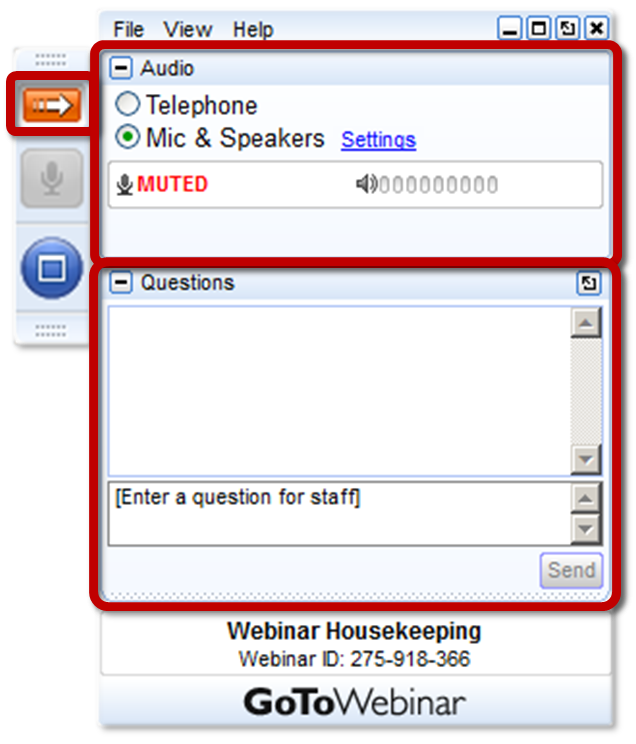
Simply getting to know them a bit and learning about why they’re at the webinar (and why they’re so eager to get started) will improve your conversion rate down the line.
At the same time, you might learn some interesting things about your audience.
Option #2 – Ask a few questions: It’s always good to ask questions during the webinar, but it’s especially good to do at the start.
Basically, when you get your viewers responding in the chat box, they get used to it. And that makes them more likely to respond to you and ask more questions in the future.
Ideally, you want to get them in this habit early.
That’s because once they realize they can actually talk to you, they are more likely to pay attention throughout the webinar so they can ask questions about something they didn’t understand.
Option #3 – Ask attendees to fill out poll or survey: Instead of asking questions and getting responses in the chat box, you can have your viewers fill out a poll or survey.
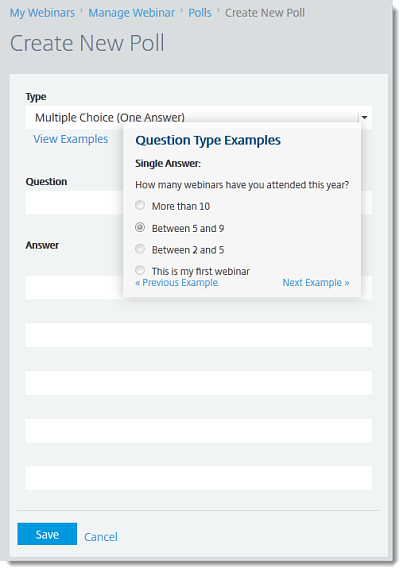
These have to be prepared in advance, so it’s best to use them for questions that reveal something useful about your audience.
Here are a few sample questions you could use:
- “How many webinars have you attended?” – So you know if you need to explain webinars at the beginning.
- “How familiar are you with [your brand]?” – The less your audience knows you, the more important personal details and an introduction become.
- “How important is [webinar topic] to you?” – Over time, you will see that your customers care more about certain topics than others. Do more webinars about those important topics.
- “How much experience do you have with [topic]? – If your audience is more advanced than you thought, you don’t want to spend too much time on the basics. The opposite is also true.
Just about every leading webinar software (e.g., GoToWebinar) comes with built-in survey and polling tools. You can see the results as people answer your questions.
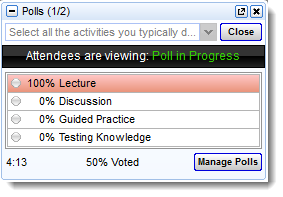
3. Don’t skip past the introduction
Now that you know how to get most of your registrants to show up for the webinar, you need to take some time to get them on the same page.
Webinar audiences consist of many different types of viewers.
Many will come from your email list—these are the people who know you and your content pretty well. But others will stumble upon your webinar and not know anything about you. Of course, there are plenty of people in-between as well.
In order for you to deliver an effective webinar, it’s important for the audience to understand that you are an expert on the topic you’re presenting on.
For the people who know you well, that’s no problem.
But for the rest, you need to introduce yourself and explain why you should be trusted.
The second half of the introduction should be devoted to introducing the topic.
Again, you’ll have viewers who have different levels of knowledge and experience on the topic you’re covering.
It’s important to break down what you’ll be covering so everyone has at least the same basic overview of the topic.
Let’s look at how to craft each part.
Part #1 – Who are you? Almost every webinar should start with a slide or two about you.
If you don’t have this already, you need to add it.
There are two parts of a good introduction of the presenter:
- qualifications
- personality
The qualifications are by far the most important.
Tell the audience the most impressive things you’ve done in your field. For me, it’s usually facts about working with companies such as Gawker and people such as Timothy Sykes.
Here’s an example of one of our introduction slides in a webinar.

On top of that, it’s always good to inject a little personality if possible. Throw in a quick joke or personal story to show you’re a real person trying to connect with your audience.

Part #2 – What are you going to cover? Once you introduce yourself, you’ll want to go over what you’re going to cover in the webinar in 1-3 slides.
Here’s an example:

Go over the main topics, but phrase that information in terms of the benefits that the viewer will get (e.g., creating marketing campaigns that sell like crazy).
First of all, this gets everyone on the same page. Additionally, it makes viewers want to stick around for the whole webinar because all those areas now sound interesting.
4. Without intrigue, you will fail
Webinars can provide a ton of value for your visitors.
But you are also asking for a lot.
They basically have to agree to spend 45 minutes (minimum) focused only on your presentation.
That’s a lot of time for many people.
You also need to consider that if at any point a viewer doesn’t like how the webinar is going, they can just click the “exit” button.
This is why your number one priority should be to keep them interested in your material.
There are a few things that go into this.
Without an intriguing topic, no one will show up: Interest starts with your topic. If you have a seemingly boring topic, no one will want to attend the webinar, no matter how good your actual presentation is.
The most important part of drawing attention is the title of the webinar. It functions exactly like a blog post headline.
Most of the same rules of writing a powerful headline apply here too.
You want to include specific results that your reader is looking for while not giving away the answer.
Here’s a bad headline:
Social media marketing efficiency
It’s boring, vague, and not provoking curiosity.
But how about:
How to plan your weekly social media marketing schedule in 60 minutes or less
That takes care of a specific problem (wasting time on social media) that a visitor might have. But it also makes the reader want to watch the webinar to find out the answer.
On top of the headline, you can also write a few high-impact bullet points on the landing page.
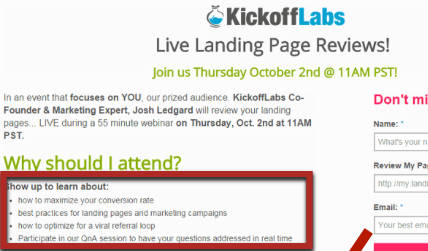
Those bullet points should contain the most important benefits from your viewer’s perspective.
In addition to putting them on the landing page, it’s always a good idea to put them on one of your beginning slides:
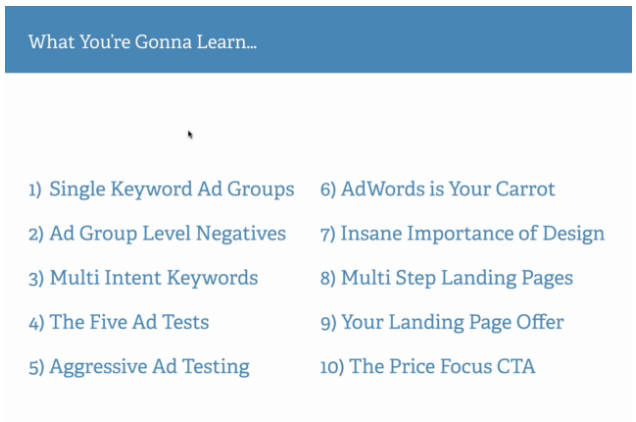
It’s easy for viewers to forget the specific reason why they signed up for the webinar, and this can jog their memory and get them to stick around.
Here’s one important aspect of picking a topic: The most intriguing topics for a webinar are the ones that act as mini-courses.
They take one specific important problem and solve it in those 45-120 minutes.
If you look at past KISSmetrics webinars, you’ll see that most of them involve the word “How”. Many headlines are “How to…” headlines.
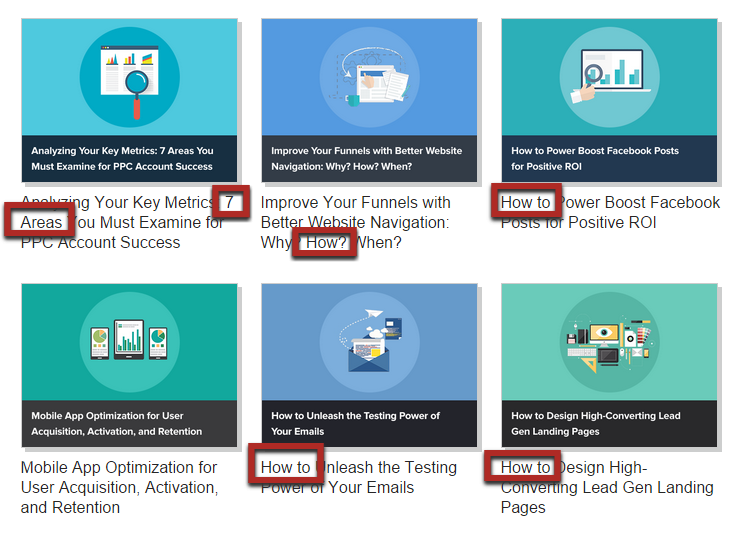
Not only are these topics the most intriguing, but they are also the easiest ones to create a great presentation around.
Your presentation becomes a walk-through of the solution.
How do you get people to stay on the webinar? After you get your audience to register and attend the webinar, you still need to keep them intrigued by your material.
While some attendees will be entranced by the presentation, you’ll always have a large chunk on the edge of leaving.
They’re either not sure if this topic is really important to them, or they already know a lot of the things you’re covering but just want to see what you say about a few key aspects.
There are two things you should do.
First, don’t reveal everything about your solution at the start of the webinar.
It’s fine to give some details, like “our solution is to use batching along with a social media calendar.” Just don’t give out too much, like how you’re going to accomplish it.
If you pick your topic right (a how-to topic), your valuable content will be automatically spread out through the steps you present, so you don’t need to worry about this much.
But if your webinar is something like “7 secrets of…”, start with a really good one, and then mention that your last one will be the best one.
Another option is to provide an incentive to viewers who watch the entire webinar.
The bonus might be:
- a recording of the webinar
- a related bonus e-book
- a transcript of the webinar (or a PDF of it)
- free coaching
- or a special offer
For example, when guest presenters help out on KISSmetric webinars, they often include a related bonus book that a huge percentage of viewers will stick around to get:
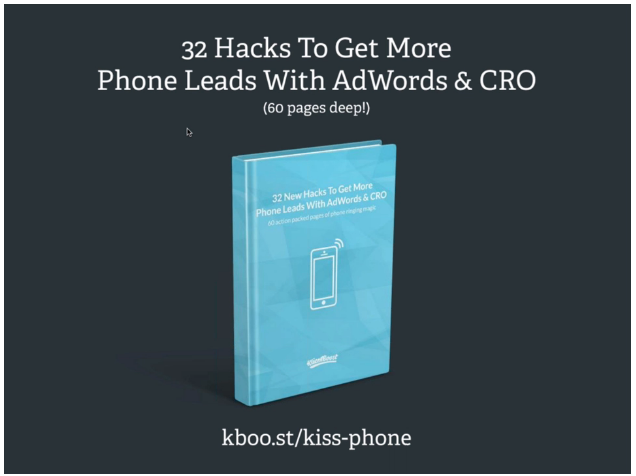
5. Speak in an engaging tone
There’s a saying about writers:
There are no boring topics, only boring writers.
And the same can be applied to speakers.
Assuming you went to a typical school (at any level), you know at least one teacher who could put you to sleep with their lectures.
But you also probably know some who held your attention even though they were teaching you about the most dull topics imaginable.
If you are a good speaker, you can turn even a poor webinar into a good one.
But if you combine great content with great speaking, you’ll start getting those conversion rates we talked about at the top of the article.
By no means do you have to be a perfect speaker to be effective, but you do need to be “good” (as judged by your audience).
We have 4 main tips that most webinar speakers can implement to improve their presentation skills.
Tip #1 – Rehearse, but don’t memorize: There are many types of bad presenters, but there are two in particular that are very common.
First is the presenter who never prepares for their webinars. They think they know their topic so well that they don’t need to prepare.
Needless to say, the laziness shows in their presentation. They frequently need to stop to figure out what they’re trying to say and where they are in the presentation.
The second type of a presenter isn’t as bad, but isn’t good either. They are the presenter who over-prepares for their webinars. Typically, they write down a script to read out, or sometimes they even memorize what they are going to say.
This type of speaker ends up sounding like a robot. Furthermore, they often freeze up while they try to remember the right words or find their place in their notes.
You don’t want to sound like you’re reading off a paper. Rather, you want to sound like you’re having a conversation with the viewers. That’s very hard to do if you memorize something.
The solution?
Practice what you’ll say before the webinar. You can make notes of talking points, but don’t do much more than that.
When you practice, mark down any areas where you don’t think you’re speaking confidently and re-do those sections.
There’s one key to this, however: you don’t want to practice too many times, or it will again start sounding too rehearsed. The more experienced you get, the fewer times you’ll have to practice ahead of time.
Typically, you’ll want to go through your presentation 1-3 times until you have a good idea of what you’ll be covering.
Tip #2 – Inflection makes speech interesting: One of the biggest causes for being put to sleep by someone is if they speak in a monotone (one tone) voice.
When you’re in a conversation with multiple people, this isn’t usually an issue because the tone will constantly be changing since different people are speaking.
But in a webinar, it’ll typically only be you, talking for upwards of 40 minutes. The audience needs changes in your speaking tone to keep them entertained.
To do this, you simply need to use inflection.
Inflection just means to emphasize certain words while you’re speaking. You slow down when saying those word(s) and sometimes even pronounce them louder.
You might have noticed that we italicize words to give them emphasis when we write. That’s inflection in writing. It gives you (the reader) something different to pay attention to as it breaks up the constant flow of normal text.
Here’s a great quick exercise to help you understand how using inflection can change your speaking.
Go through the sentences in the picture below, and emphasize the highlighted word in each sentence as you read them out.

Notice how the same sentence takes on a different meaning each time you read it. Also notice that you inject more emotion as you emphasize the words. That’s how your speaking comes across to your viewers during a webinar.
Start emphasizing words on a regular basis. Don’t go for an overkill, but do emphasize a word or phrase every 3-5 sentences.
Tip #3 – Don’t rush: One thing common in all public speaking is rushing through presentations.
A lot of it comes from nerves, but another part of it comes from thinking that your audience has a limited amount of attention.
But here’s the thing: people won’t stop paying attention if they’re really interested in your presentation.
When you rush, you make it harder to understand you, which makes it harder to understand and process your message.
Instead, take a slow, even breath once in awhile when you are presenting in order to slow yourself down.
More importantly, use pauses to vary your speaking tone even more. When you pause before saying a word, it serves as a signal to listeners to pay attention because something important could be coming up next.
Don’t worry about people leaving. Just speak naturally and at a normal pace.
Tip #4 – Practice: If you’re not confident in your speaking skills, you are not alone.
Doing presentations is very difficult. You have to present live, and you don’t get the benefit of several rounds of edits of your material like you do with blog posts.
And even though we’ve done hundreds of webinars and spoken at even more conferences and events, we still find ourselves improving.

The only way to improve is to practice.
There are two key things you should do to make your practicing more effective.
First, watch and listen to your own webinars. That’s the only way you can evaluate what you sound like and spot mistakes to fix.
Second, watch webinars of marketers you love. Start emulating their way of speaking and relating to their audiences.
6. Interaction is key, but make it simple
Your main goal as a presenter is to keep your audience entertained and engaged.
We just talked about trying to be as conversational as possible throughout the webinar.
And unlike blog posts, webinars are live. This means that you can, to a degree, have a two-way conversation with your viewers.
There are a few ways you can do this.
Ask questions, and call out participants by name: Every piece of webinar software we’ve used or seen has a chat function.
Viewers may not be able to interact with you using their microphones, but they should be able to interact with you through the chat box.

This is the primary feature of webinars that you need to take advantage of.
Ask questions throughout the webinar, sort of like having mini quizzes.
Our webinars are typically on customer acquisition and building profitable businesses, so we might ask questions like:
- Do you notice any of these problems in your business?
- What kind of industry are you in? Do you think this tactic would work for your audience?
- Does that make sense?
The questions should be related to the topic at hand.
Pause the presentation while you ask the question and give your participants a minute to type in their responses.
Then, you need to reflect their answers. It’d be great if you could call out viewers by name (e.g., “that’s a great answer, Janet…”).
Make it sound like a real conversation.
Surveys and polls can be useful, but keep this in mind: In addition to the chat box, some webinar software will offer you advanced tools such as surveys and polls:

These are really useful if you want to get your viewers engaged, but they are also handy if you want to collect some information about audience to help you refine your marketing.

What you need to be careful of is using too many of these features.
First of all, while they are simple to use once you’re used to them, first-time webinar viewers might get confused if you’re asking them to complete a survey, take a poll, and use the chat box all at once.
We recommend to keep it simple and pick just one type of advanced tool to use.
Also, while surveys and polls can be nice breaks from the content, they get boring if used repeatedly, so limit their use to once every 15-20 minutes at the most.
Make sure your audience knows when to ask questions: Finally, you want to encourage communication with your audience.
Many of your participants will have questions about your presentation. Before you get started, let them know that you will have question periods throughout the presentation when they’ll be able to ask questions through the chat box.

The reason why this is important is because if they type in a question at any random time, it might accidentally get skipped over as people reply to questions you ask them.
Additionally, clarifying when you’ll have the question sessions keeps viewers from getting anxious about not knowing how to ask or whether they’ll be able to.
7. Follow a proven content structure
If there’s one way to guarantee that a viewer leaves your webinar early, it’s to make them confused.
If you’re jumping around from one topic to another, but it’s not clear how they’re connected, you’re going to confuse your audience.
Obviously, this isn’t good for your viewers or your conversion rate.
Instead, you should apply a copywriting framework to your webinar.
There are many frameworks you can use, but one that fits well with webinars is the P.A.S.T.O.R. model.
Here’s what it stands for and how to apply it:
- Problem – Start the webinar with identifying and clarifying the problem you’re trying to solve.
- Amplify – Go into as much detail as possible to illustrate why it’s important to solve it. You want viewers to feel the pain that the problem causes (or the benefits you can deliver) so that they’re motivated to pay attention and take action.
- Story/Solution – Now you get to describe your solution to the problem. If possible, tell the story of how you came across it and describe how useful it is.
- Testimonials – If your solution really works, you should be able to point to people or businesses who have been successful with it.

- Offer – After you’ve given away all your value and reinforced that your solution is awesome, it’s time for your offer. Explain how you can help implement the solution for them with a service or product.
- Response – This is equivalent to a call to action. Ask the customer to take action if they want to improve their lives or businesses right now. Be explicit, clear, and tell them exactly what to do (e.g., “go to this link” or “send me an email here…”).
If you stick to that model, your presentation will logically flow from one section to another. Your viewer will feel like they are watching a story unfold until it’s time for them to take action.
8. Examples matter more during webinars than at any other time
Webinars by their nature typically allow you to focus on a single strategy.
This means that the people who signed up to attend are very interested in that topic/strategy. They want to apply your lessons to their businesses/lives.
But learning something new and thinking about how to apply it at the same time is difficult.
That’s where examples come in…
If you can give real examples illustrating the concepts you’re teaching, you’ll give the viewers extra opportunities to understand how those concepts connect to their lives or businesses.
The more examples, the better.
We provide examples of specific tactics mentioned in our webinars:

…as well as real examples of implementing of the strategies, similar to mini case studies:

The bottom line is that your viewers want to apply what you’re talking about, but they don’t always know how.
Make it as practical as possible by providing examples whenever possible.
9. Every part you teach needs to accomplish one thing
A webinar is all about giving value, but it’s about giving the right kind of value.
It should educate your audience about their problems as well as potential solutions to those problems. This is valuable to any viewer.
At the same time, one of the solutions you show them will likely be a product or service you sell.
Assuming it’s legitimately a great product that solves the problem or makes the solution as easy as possible, all you have to do is present the product honestly when the time comes.
Until that time, everything in your presentation should have two purposes.
Phase #1 – Make the pain worse or the benefit better: Viewers sign up for webinars for two main reasons.
Either they have a problem that is causing them or their business pain and they want to solve it, or you’ve made a great promise that they’d like to get.
Here’s some examples:
- Pain: “I’m not getting any organic search traffic.”
- Webinar: “7 steps to ranking #1 for long tail search terms”
- Benefit: “I wouldn’t mind making more money even if I’m doing okay now”
- Webinar: “6 ways you can make an extra $1,000 per month”
Whatever the reason, you need to mention it early on. Remind them why they are there and what they will get out of the webinar if they stay for the whole thing.
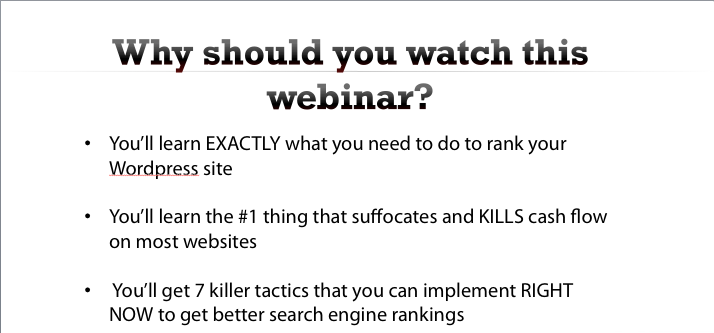
When you do this, your viewers will pay closer attention to your presentation, and that’s when you jump into phase #2…
Phase #2 – Educate viewers about a solution: Don’t just educate them in general—educate them about specific solutions.
This will be the meat of your presentation, where you break down solutions, step by step:
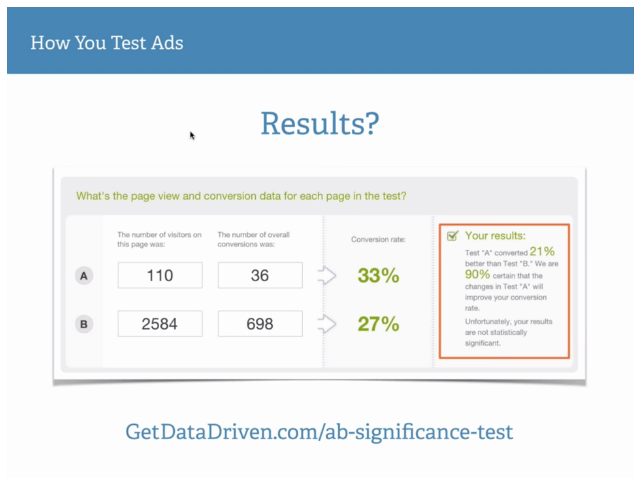
Most viewers don’t care about the technical stuff going on in the background. They just want solutions that they can apply.
Among the solutions, you can include your product.
Or you might pitch your services at the end, offering to solve this problem for them.
10. A buying audience is an engaged one
We’ve mentioned a few times so far how important an engaged audience is.
Let us clarify what we mean by that. Engagement is a measure of how much focus your audience is giving your webinar.
If you have low engagement, it means that people aren’t paying attention, despite watching the webinar.
It could mean that they’re zoning out maybe because the presentation is boring, or it could mean they’re distracted by email or social media.
A small percentage will just keep the webinar on to see if you offer a free bonus at the end, but don’t worry about those viewers.
A highly engaged audience will watch everything, and a decent portion of those viewers will jump at the chance to interact with you.
The more involved viewers are with you, the more invested they will be in the solutions you’re presenting.
The people who are talking to you the most during the webinar are your best leads for sales.
It’s obvious that getting your audience engaged is a good thing.
Here are a few different ways you can encourage engagement.
Idea #1 – Launch a poll: Every once in awhile, it makes sense to see if viewers are actually understanding what you’re saying and getting value from it.
If you’d like to do it informally, just ask a question and get responses in the chat box.
But if you also want to know if you’re presenting effectively, a poll is a good idea because you’ll get concrete feedback.
It’s a good idea to launch a poll or quiz immediately following a particular section. Ask the viewers about the main takeaway, for example.
Not only will it give you good information, but it will also make your viewers solidify their learning.
Idea #2 – Don’t read from your slides: One way to bore your viewers quickly is to create slides with a ton of words on them and just read them out loud.
If you’re going to do that, why do they need you?
Instead, put a few words on a slide, which attract attention, but fill in the blanks yourself.
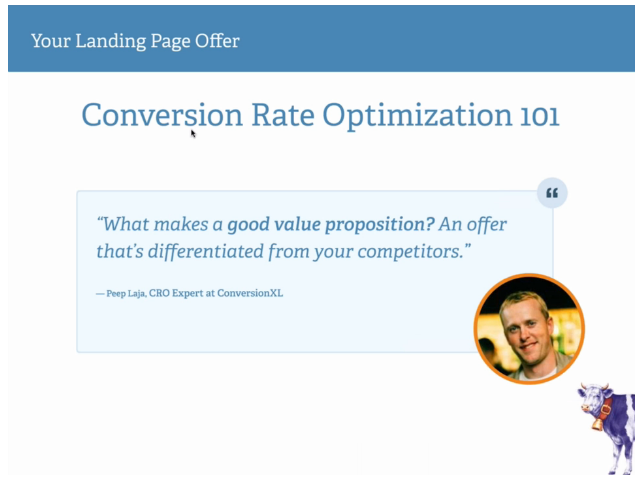
Idea #3 – Mention viewers by name: This tactic is great at making your viewers feel more involved.
Instead of just being a screen name typing into a chat box, your viewers can feel like they are part of the webinar if you address them by their names along with saying something positive:
That’s a really good question, Neil! …
If you, as a viewer, get a personal compliment from an expert teaching a large audience, you’ll feel good about it. And chances are, you’re going to look for more opportunities to contribute and stand out from the passive viewers.
Idea #4 – Small webinars can be better than large ones: The default tactic is to try to get as many people to register for your webinar as possible. It’s not a bad one.
However, if you have a particularly complex product, you’ll need to be able to explain whether your product works for all specific situations that your viewers might have.
This is impossible if you have hundreds of viewers on the webinar.
But if you only had 25-50, you could cover quite a few scenarios and make a few big sales.
First, you should make it clear on the landing page that only 50-100 seats are open for the webinar (about half to two-thirds will show up).
Then, note the audience size right away at the start of the webinar. Say something like this:
I’ve kept the webinar really small on purpose; there are only 50 people here. I did that so I could talk with more of you one-on-one to find a solution that works for you. In order to do that, I need you to type in any questions or comments you might have along the way in the chat box.
11. It’s closing time
If you’ve done everything up until this point right, making your pitch is actually really easy.
You’ve given away most of the value you promised, so at this point, it’s just a matter of giving away your bonuses (if you have any) and tying in your product or service with the solutions you just provided.
First, transition into your offer smoothly: The only way to really mess up at this point is to say, “Well, that’s all I have for you today. Now I want to show you a product to buy.”
As soon as you say something like that, the viewers will feel like they are being sold to, and no one likes that.
With a webinar, there’s an understanding that at the end you might make an offer, but it should flow naturally from the topic of the webinar.
The offer should have two qualities: it should be unique and valuable.
For example, if the webinar is about conversion optimization, I could offer a discount on Crazy Egg software.
First, that’s unique because they wouldn’t be able to get that discount anywhere else.
Secondly, it’s valuable because people who are learning about conversion optimization will need heatmap software, and Crazy Egg is among the best options.
It’s crucial that you tie your offer into how it will benefit the viewer in the context of the webinar topic.
Hold a Q&A session after the pitch: Before you even mention your product, tell the viewers that you will answer any questions they have in just a minute.
Although a large percentage of viewers will drop off here, the ones that stay are the ones that are really interested in your solutions.
By doing the Q&A after the pitch, you are forcing your viewers to at least listen to the pitch if they don’t want to miss the Q&A session.

Plus, making the pitch before your Q&A will allow you to answer questions about both the webinar material and your offer.
Once you’re done with the questions, you can finish the webinar with one last mention of your offer.
12. You’ll miss out on a large amount of sales if you don’t do this
If you’re selling a particularly expensive product, you can’t expect all your viewers to be ready to buy right away even if you give them a great offer that they are interested in.
Some people will want to think about it a bit more, while others will need to get an approval of a boss or their significant other.
That doesn’t mean that they won’t take you up on your offer; it just might not be the second you give it to them.
Additionally, depending on the time of your webinar, some attendees may just want to go to sleep or have to go somewhere.
Neither of these scenarios allow time to carefully consider a major purchase.
So, what should you do to maximize your conversion rate? Follow up with them within 24-48 hours.
Assuming you’re using software like GoToWebinar, you will have access to all of your registrants’ email addresses.
This is your chance to provide even more value (which will help get a high email open rate) while also getting your offer in front of viewers one last time.
Here’s what a good follow up might look like:
Subject: Recording of last night’s webinar on [topic]
Hi [name],
I know that we covered a lot in the webinar yesterday, and it’s easy to miss things. That’s why I’ve put up a recording of the webinar that you can stream or download. Here’s the URL:
[URL of the webinar]
If you still have any questions about what we covered, just reply to this email, and let me know what they are.
Additionally, you still have 48 hours to take advantage of the 20% discount.
This is a pretty special offer that doesn’t come around very often, and I feel you could really benefit from [product] in 3 ways:
- (benefit #1)
- (benefit #2)
- (benefit #3)
If you want to take advantage of the offer or want more information, click here:
[URL of the landing page]
Best regards,
[your name]
No hard sell—just the last chance to get your offer in front of your viewers. If they are ready to become customers, they will do so now.
If not, don’t worry about it. If they enjoyed this webinar, they’ll likely sign up for a future one and might buy from you later.
That’s the beauty of webinars. They’re still part of your content marketing plan, and even if they don’t directly lead to a sale, they will help build your brand in the eyes of your attendees.
Conclusion
Webinars are one of the most powerful traffic generation and conversion tactics that exist right now.
They offer a unique opportunity to engage with your potential customers, which no other form of content can match.
They also have a high perceived value, which means that attendees typically focus on the webinar the entire time, assuming that it’s interesting.
Take advantage of them.
We’ve shown you 12 tactics you can implement right away to produce better webinars for your audience. If you implement them as we’ve shown you, your attendance rates as well as your conversion rates will go up.
